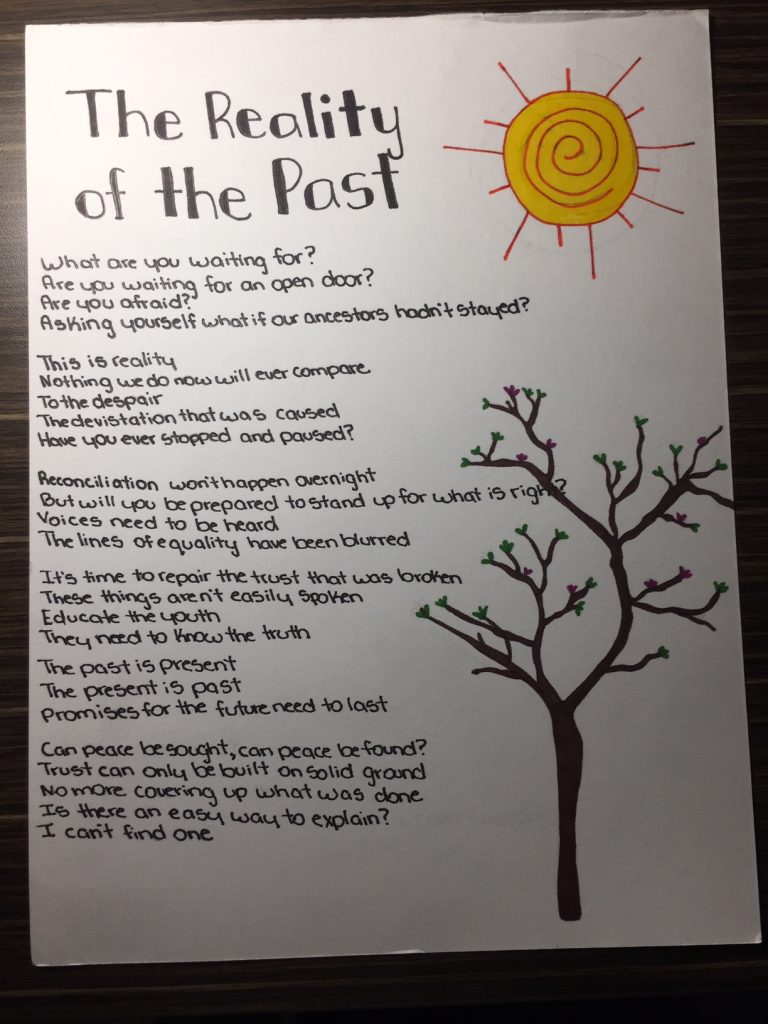For my visual representation of my journey to reconciliation I wrote a poem titled ‘The Reality of the Past’. This poem highlights the unforgivable past of my, white settler, ancestors. This project convicted me to dig deeper, to ask myself the hard questions. Some of these questions included: what does it mean to educate students about truth and reconciliation, and what type of responsibility does this bring?
The poem I wrote has the word ‘truth’ repeated numerous times. I think it is imperative that we start teaching truth of the past to our students. A responsibility we have to our students and to the Indigenous people is relaying true information in our schools. We can no longer hide the past but try to grow from it. In my poem I tried to incorporate some hard questions that we as white settlers need to ask ourselves. I think it is important to look to ourselves in terms of what reconciliation means to us. I think we need to realize that what was done in the past won’t just go away and we need to be aware of what has happened and how to move forward.
I learned a lot about my own personal journey to reconciliation through the writing of this poem and through looking at class resources to obtain inspiration for the poem. Something that stuck out to me from lecture is that we are all called to action in learning our shared history with the Aboriginal people. I think that is a powerful message and is something that I am going to strive for in my classroom someday. To be able to have a better future we need to recognize the past and that a simple apology will not fix a lifetime of pain colonizers have caused.
I drew a tree on the side of my poem because I thought it symbolized new growth. As we as residence of treaty territory start on this journey of reconciliation, there will be new growth and life. By realizing the past and striving for a better future we as a nation will grow. I think the impact us as educators have on the future is also something to consider. If we raise children to understand the injustices of Canadian history maybe Canada will be able to overtime grow together in unity.
The book we were gifted on Truth and Reconciliation and the documentary Muffins for Granny were the starting point for my personal reflection on this topic. I think these are both great resources for a classroom and I am going to add them to my E-portfolio. The Truth and Reconciliation book was a great source to find student’s voices on the topic. The book opened my eyes to residential schools and the impact they had. Muffins for Granny also gave me more insight into residential schools, and I found myself getting emotional listening to the stories. In my poem I tried to recreate that emotion I felt when watching the documentary and how it is so important to talk about these topics even if they are hard.
My journey to reconciliation is not over, there is still so much more I want to learn and more growing that I want to do on this topic. I think as a future educator I have a responsibility to my students to provide them and their families with the information and sources they need to also start on their own journey to reconciliation.

References
Canadian Teachers Federation. (2016). Truth and reconciliation: what is it about? Ottawa.
Mongrel Media Inc. (2007). Muffins for Granny.
Machnaik, J. (2019). ECS 100: Journey to Reconciliation, Week 5 notes [PowerPoint slides]. Retrieved from https://urcourses.uregina.ca/course/resources.php?id=14877